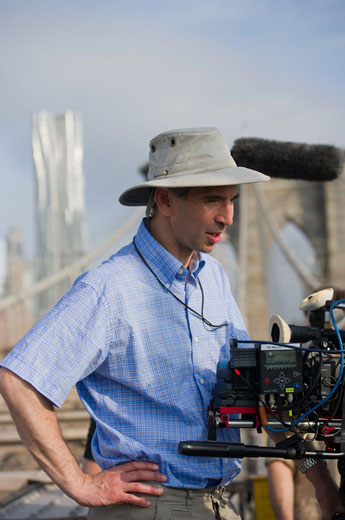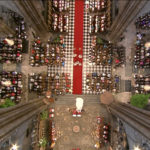
Sony’s F3 Shoots David Bailey Drama For BBC
Posted on Jun 20, 2011 by Alex Fice
Jean Shrimpton (Karen Gillan) and David Bailey (Aneurin Barnard)The last time HD Magazine spoke to DoP Tim Palmer was last year about his part in the production of The Road To Coronation Street single drama for the BBC. The unusual thing about the shoot was that, due to circumstances and a certain amount of curiosity on his and the BBC’s part, the main camera was the Canon 5D MkII DSLR, it ended up shooting about 85% of the show. If the drama hadn’t been and hadn’t looked so good there probably wouldn’t have been much of a story, but it looked spectacular and has gone on to win a television BAFTA for Best Single Drama, hence much gnashing of teeth about further use of the camera for broadcast.
There’s no doubt that the BBC’s technical department despise the Canon camera for it’s technical shortfalls and have said so publicly but theirs is a mixed brief. One one hand they must advise on equipment choice based on solid technical research, on the other they are supremely encouraging to film makers to find a solution when great visuals don’t exactly match their exacting requirements.
Tim’s latest BBC drama is similar to his last inasmuch as it’s low budget, a period piece, it’s for the superb BBC 4 and there’s a new camera to use that could bring that elusive ‘cinema-like’ look TV producers are looking for nowadays.
The piece is called We’ll Take Manhattan and tells the story of famed photographer David Bailey and his muse at the time, Jean Shrimpton around the time of some breakthrough shooting sessions for British Vogue Magazine. Tim takes up the story, “On one level it’s about their love affair and on another level it’s about the burgeoning new wave of freedom, youth and sexual liberation of the sixties. Essentially it’s about David Bailey’s battle against the old guard at British Vogue. The film records the trip that he took to New York in 1962 with Jean Shrimpton and Vogue’s formidable fashion editor Lady Clare Rendlesham.”
To realise how groundbreaking this shoot for British Vogue was you had to know what had gone before – a much more sedate and contrived way of shooting fashion photographs that originated with Cecil Beaton. Bailey unwittingly changed everything with his involvement of the city’s underbelly and real character with Shrimpton dropped right in the middle of it, it engendered a photojournalistic quality which is much of the norm today. At the time it was frowned upon by fashion’s old guard, now it’s seen as seminal.
Earlier this year Tim had a commission from Channel Four to film a series of dramas called Coming Up, this was a platform for new writing talent, the shows were 30 minutes in length. He was looking to use the new Sony F3 camera on them had it been available but ended up using his Canon 5D MkII. But when the ‘Bailey’ drama came up he thought again about the F3, “John McKay, the film’s writer and director, and I have worked together many times on shows like Life On Mars, Robin Hood and Hustle. He had been talking to me for years about the drama and it was finally green lit at the end of last year. Camera conversations came up immediately and he was very interested in the 5D. My opinion was different because the show was going involve a lot of handheld work. The 5D wouldn’t be suitable because we would always struggle with focus. It works very well when you can exert some control by keeping it on the dolly or the tripod. The moment you go a little bit free and easy it’s a nightmare!
“So we actually went back to the idea of shooting 16mm, it seemed like the best format for the job because it would symbolise the sort of era that film was trying to describe. Cost wise it would’ve worked but the BBC Technical department categorically said ‘No’.
“We then looked to shoot it on the Alexa but they are as rare as hen’s teeth now and the camera hire companies are not doing any deals. This left the F3 really which the BBC had given me a demo of. It wasn’t our first choice but by default it fitted the bill and we could afford it.”
Living with the Sony F3
 DoP Tim Palmer loved the F3’s imagery but had problems with some of the ergonomicsTim had just come off the latest series of Doctor Who and used the Sony F35 so coming to the F3 was keeping it in the family to some extent. “The pictures don’t look that different. Obviously it’s doesn’t have that compression-less 4:4:4 or Log C recording (although a current ‘paid for’ firmware update for the F3 should allow that) but out of the camera and on to the monitors it looked gorgeous. The F35 is a magnificent camera, ergonomically its a bit of a beast but it takes great pictures.”
DoP Tim Palmer loved the F3’s imagery but had problems with some of the ergonomicsTim had just come off the latest series of Doctor Who and used the Sony F35 so coming to the F3 was keeping it in the family to some extent. “The pictures don’t look that different. Obviously it’s doesn’t have that compression-less 4:4:4 or Log C recording (although a current ‘paid for’ firmware update for the F3 should allow that) but out of the camera and on to the monitors it looked gorgeous. The F35 is a magnificent camera, ergonomically its a bit of a beast but it takes great pictures.”
Tim rated the Sony F3 at about 320ASA which for him was like shooting on fast film and pretty much matched up to the way he lights usually so no surprises. But there were other cameras to check out first
“I did look at the Panasonic AF101 but it wasn’t suitable. It had a more electronic look and the overall construction of the camera was not up to par. The lens mount always felt loose and there was a problematic amount of play between the lens and camera body. I think maybe for a owner operator who is going out shooting documentaries or corporates it’s fine but for a full length drama it would have fallen to bits within the first week. We compared it very closely to the F3 and the bottom line is that the F3 delivered much more filmic looking images.
“I can’t fault the F3 one bit in terms of it’s visual aesthetic, though to be fair this camera suffers equally from an overabundance of cheap plastic parts which break.“
Tim rented a package from the UK’s Visual Impact which included a set of Zeiss Super Speed primes. These lenses could be twenty years old so they’re not as sharp as say Cooke S4s or Zeiss Ultra Primes but Tim wanted a lens kit that could fit in one small lens case and physically, Super Speeds are half the size of anything else. He realised that they were a little bit softer than modern lenses but that was an advantage. Also, “They are very fast with a T1.3 maximium aperture. Normally I’ll stop down, but I knew that in New York at night we would need the ability to shoot wide open at 1.3 because we weren’t able to light anything.”
What he wasn’t ready for was the route he would have to take to record any footage, “Natively the camera records at a data rate of 32Mbps which is not enough for the BBC who require a minimum of 50Mbps. This isn’t a problem as the BBC’s advice is to record to an external recorder like the Convergent Design NanoFlash that bolts on to the side of the rig. The unit is the size of a pack of cigarettes and is very discreet. However because there is nowhere to attach it to the actual camera a longer set of bars becomes necessary which juts out the back of the camera. This means that the camera has almost doubled in length just to mount a 4”x3” box. Still, in theory it’s very simple. You put in your CF cards, set it and off you go. But there is a degree of misinformation about what data rate and format you shoot at. We were guided by Molinare and Kudos’ (the production company) post production supervisor as there is a far bit of CGI work to be done.
“They quite understandably recommended that we shoot at the maximum rate of180Mbps which the NanoFlash recorder handles perfectly well. So we set it up to shoot at 180. There were no problems during the test week but once we started shooting the recorder was crashing at least five times a day. Everytime this happened the card would need to be removed, checked and replaced and then the whole system would be reset and rebooted – about a ten minute operation. So we were losing about an hour a day on crashes. Fortunately we never lost anything because the camera was recording simultaneously onto its own SxS cards albeit at a lower data rate. “
“This went on for two weeks in the UK and then the unit was moving to New York. We couldn’t risk working like this in the USA as time was extremely limited and we did not know the crew. I suggested that we ditch the recorder and just shoot with the SxS cards. Although it would be at a lower data rate, we had done tests and the material looked perfectly good. However the BBC were keen for us to maintain shooting at the higher bitrate.
“I had a day off before traveling to New York and went in to the BBC, Ian Potts there was very helpful and got all his tech team in and went through everything to try and work out why this was happening. He then said ‘Why are you shooting at 180Mbps?’. I said that you told us to and he quite rightly corrected me and said that it was our post production that had asked us to. ‘We don’t need you to shoot any higher than 100Mbps’. So that’s what we did. For New York the recorder was reset to 100 and it behaved impeccably. In hindsight we should have thought to do this earlier. But the best solution would be for Sony to up rate the native data rate on the camera (Arri’s ALEXA records ProRes to SxS at 220Mbps). Having an after market device hanging off the camera necessitates other peripherals to be plugged in to it. Extra batteries, more cabling, it affects the balance of the camera and the way the viewfinder works. There is a host of ‘knock on’ effects.
“We were in some very tight locations, one of which was an old BOAC airliner at the Imperial War Museum in Duxford. We couldn’t remove any seats so on this occasion, in order to fit in between the rows of seats we took the Nanoflash off and had it tethered. Finally the camera was the right size – as it looks in all of Sony’s publicity pictures! It was perfect for these tight, handheld spaces and reminded me of an Aaton Minima.
“The other problem is the viewfinder system. I’m not saying it hasn’t been thought through but there is an old camcorder ancestry there that is still very much in evidence. The little flip-out viewfinder is pretty useless unless you’re in a really tight spot and can’t get to the eyepiece. The video viewfinder eyepiece that comes straight out the top of the camera is even worse and was like trying to look through ‘fizzy mud’! So we used a CineRoid viewfinder which gave an excellent picture and truly allowed me to light and operate properly. However mechanically it did not come without its own set of problems. Firstly it has an HDMI connection and the F3 has no HDMI out. Therefore it had to be fed from the Nano flash recorder. Secondly it is self powered and the batteries do not last long. A day’s work would use up four batteries and there was no warning before a battery ran out. I’d always keep the flip out viewfinder open so when this happened there would be something to look at and I could continue framing the shot.
“Having said all that the actual camera pictures look tremendous.
Capturing The Mood
Without a big crew or a big budget Tim and director John McKay had to decide to design a look for the drama, the first stop was to research the famous photographs which are available freely to view on the web. “The look then was a typically exaggerated colour that would come out of the primitive reversal films. Kodachrome and particularly early Ektachromes never looked quite real. I kept things as neutral as possible in the camera as any subtle colouration effects are so easy to achieve in the grade. However one thing that did work rather well on day exteriors was to leave the camera at 3200K and use an 85B filter instead of setting the camera to 5600K. This gave a pleasing warmth to the skintones whilst still keeping good colour separation across the spectrum. Apart from that some light pro mist diffusion helped to make the highlights glow.
To illustrate and photograph fashion shoots there was much handheld work and for the last week Tim was allowed one of the new Angenieux DP series lightweight zooms which proved to be very versatile. However contemporary New York provided an almost insurmountable hurdle. “Because we had no artistic control over our environment but still had to make it look like 1962 we had to be extremely judicious in our angles. Ironically, handheld work was virtually impossible because the framing had to be so controlled. If you panned off a few degrees something modern would come into frame. Therefore a lot of the New York material was tripod based using the zoom to get some movement. Generally we had to use lower angles looking up into the buildings and skyline in order to avoid modern cars and pedestrians.
Having said that the other advantage of using T1.3 primes is that even in broad daylight with lots of ND, shooting at that stop threw the backgrounds sufficiently out of focus to enable us to shoot quite successfully with modern New York life going on behind.
Putting The F3 In Its Place
Overall Tim Palmer was immensely pleased with the results he got from the PMW-F3 although he like our reviewer Adam Garstone has difficulty identifying it’s niche in the camcorder marketplace. “It is difficult to work out how an owner operator (which these cameras are clearly targeted at) will be able to get the best out of it. Essentially it is still a 35mm camera and how will anyone manage without the normal compliment of camera crew? Unless you are shooting static interviews or using extremely wide lenses, if you are on your own trying to do it all yourself you are guaranteed to end up with a large amount of unusable material. The advantage of being a one man band with a 5D for example is that you have access to a much wider variety of lenses which can be managed alone including extreme wide angles at an affordable price. Right now the F3 can only accept PL mounted cine lenses. A 12mm Zeiss might set you back upwards of £15,000.00. A Canon L series 14mm is yours for £1,500.00
We’ll Take Manhattan is part of BBC 4’s Summer / Autumn schedule













